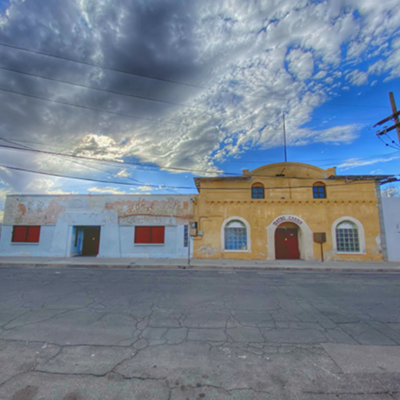After all, that's what the Canadian company says it does, although it has yet to actually sink any pits--anywhere on the planet.
So imagine the confusion of residents near the proposed mine when Augusta bought another ranch right next door, and started running cattle. This raised immediate questions. One: Are there actually Canadian cowpokes? And two: What the heck is Augusta really up to?
The answer to the first question: Sure, why not? The answer to the second question is murkier. But according to skeptics who keep tabs on Augusta, the mining company likely purchased the Singing Valley Ranch for its water rights, and as a place to collect noxious runoff from the mine planned next door.
Fueling suspicions is the fact that Augusta has been snatching up properties around Rosemont Valley in the Santa Rita Mountains, and currently owns 18 separate parcels--including leased government land--totaling about 30,000 acres.
Not surprisingly, Augusta vice president Jamie Sturgess dismisses those fears. He says his company is buying all of that ranchland just to demonstrate its commitment to preserving open space and the area's traditional vocation.
"We have said in public, throughout this entire process, that our long-term goal with the Rosemont Ranch is to continue running a ranching operation while we develop the copper mine, while running the copper mine and following the cessation of operations of the copper mine."
He says Singing Valley fits that bucolic scenario nicely, "with a corral and a headquarters for our full-time ranch staff, which is pretty modest. It's a cowboy family and a caretaker."
Still, Augusta's neo-cowpokes do need to fine-tune their cowboy vernacular: "We were at about 300 cow-calf pairs," Sturgess says, "and with the addition of this 11 acres of fee land, and over 4,000 acres of grazing leases, it puts us at a little over 500 cow-calf units, which we believe is an economically sustainable business size for a ranch."
You won't find many cowpunchers talking like that. Nor will you find many nearby residents who don't think Augusta's claims are pure hokum.
Fred Tahse, a retired mining geologist, lives in Green Valley. Tahse spent a career exploring for minerals and knows the Santa Ritas like the back of his hand. He can't see any reason for Augusta to buy Singing Valley except for its vast water tentacles.
"Geologically, the valley area that includes the Empire Gulch preserve--that the ranch lies along--is like a huge bowl filled up with gravel," Tahse says. "We don't know how much water is in that bowl, but if you put in a straw, you should, while you suck on that straw, be able to draw water from a pretty large area toward the straw."
Which brings us to one of the major controversies surrounding Augusta's plan: The proposed open-pit mine would consume about 5,000 acre-feet of water each year (an acre-foot is roughly 326,000 gallons). In 2006, the company received approval from the Central Arizona Project governing board for the purchase of 10,000 acre-feet of water annually for the next five years. The water would be used to recharge the aquifer.
But red flags went up last summer, when the Community Water Company of Green Valley announced a deal with Augusta that would have the mining company build a $15 million, 9-mile CAP pipeline almost to Green Valley, from the current terminus at Pima Mine Road.
According to Augusta officials, this generous arrangement was aimed simply at easing Green Valley's future water concerns and fostering good will toward the mine.
Others smelled a rat. Among them was Pima County Supervisor Ray Carroll, who questioned Augusta's promise to fund that pipeline regardless of whether the mine was ever begun--despite repeated assurances by Community Water President Arturo Gabaldón.
"Saying something 1,000 times doesn't make it true," Carroll told the Arizona Daily Star. "It's certainly tied hand-and-glove to the mine."
Only later was it revealed that Augusta's much-touted altruism included a handy little valve on the Green Valley line to divert CAP water to the Rosemont mine.
And so it is understandable that many were skeptical of Augusta's plans for the Singing Valley Ranch. Those concerns were heightened by events in Washington, D.C., where Arizona Representatives Raúl Grijalva and Gabrielle Giffords have sponsored legislation to stop all future mining claims on federal land in Santa Cruz County and Pima County.
Augusta is currently the largest holder of such claims, with about 900. The legislation could require the company to prove the mining viability of those unpatented holdings--or restrict the company from using them to dump mine tailings, runoff and other waste.
Ergo the Singing Valley Ranch.
Asked about these concerns, Sturgess hedges. "We have no plans to use water from the Singing Valley Ranch in the operation of the mine." Regarding runoff, "I can't make future predictions," he says.
Regardless of where the truth may lie, Augusta has sparked consternation among local officials, who worry about the impacts of pumping water from the Singing Valley Ranch. While the company touts its CAP deal, experts such as Tahse note that Augusta does not have guaranteed access to CAP water for the potential 20-year life of the mine. Should that CAP flow ever be stopped, groundwater would no longer be replenished.
County officials also worry about impacts on the water table from an open-pit mine, and the effect of noxious runoff on nearby Cienega Creek. In a recent county report, hydrologist Tom Myers noted that the mining pit "would lower the regional water table up to 1,500 feet." He also contended that the aquifer southeast of the site, which drains toward Cienega Creek, would draw groundwater north toward the pit, thereby reducing the flow to Cienega.
"The proposed project would intercept substantial amounts of groundwater discharge to the downstream basins," Myers wrote.
The mine could also have a devastating affect on those neighboring streams if Augusta uses the Singing Valley Ranch for mine runoff.
"Empire Gulch is a principal drainage (area) of the mine site," says county hydrologist Julia Fonseca, "in addition to being an area of great hydrological concern to us along with Davidson Canyon, Barrel Canyon and Los Posos Gulch. Its flow goes straight into the Cienega Creek basin."
Nor was County Administrator Chuck Huckelberry reassured by Augusta's claims of safeguarding the environment. "Previous work based on examination of 70 (environmental impact statements) for modern hard-rock mines in the Western United States found consistent underestimation of water quality impacts," Huckelberry wrote in the report.
If federal officials agree--or if Grijalva's legislation succeeds--Augusta's dream of mining the Rosemont Valley may go splat, just like all those cow pies on its lovely Singing Valley Ranch.









